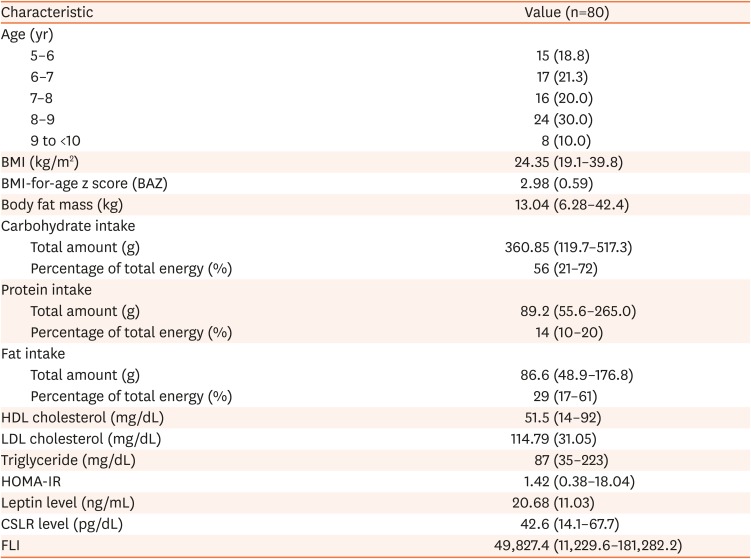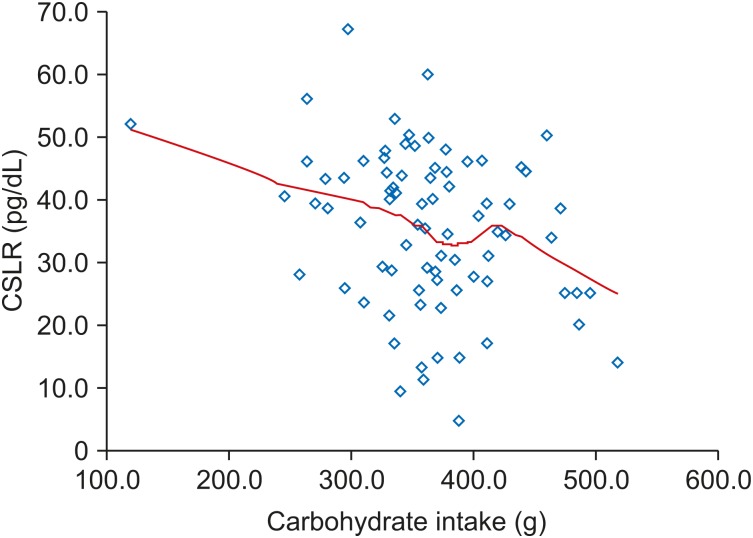1. Nishtar S, Gluckman P, Armstrong T. Ending childhood obesity: a time for action. Lancet. 2016; 387:825–827. PMID:
26823046.

2. Indonesia. Badan Penelitian dan Pengembangan Kesehatan. Riset kesehatan dasar: riskesdas, 2013. Jakarta: Badan Penelitian dan Pengembangan Kesehatan, Kementerian Kesehatan RI;2013.
3. Kementerian Kesehatan. Badan Penelitian dan Pengembangan Kesehatan. Hasil utama RISKESDAS 2018. Jakarta: Kementerian Kesehatan Republik indonesia;2018.
4. Klöting N, Blüher M. Adipocyte dysfunction, inflammation and metabolic syndrome. Rev Endocr Metab Disord. 2014; 15:277–287. PMID:
25344447.

5. Harris RB. Direct and indirect effects of leptin on adipocyte metabolism. Biochim Biophys Acta. 2014; 1842:414–423. PMID:
23685313.

6. Elias CF. Leptin action in pubertal development: recent advances and unanswered questions. Trends Endocrinol Metab. 2012; 23:9–15. PMID:
21978495.

7. Kennedy A, Gettys TW, Watson P, Wallace P, Ganaway E, Pan Q, et al. The metabolic significance of leptin in humans: gender-based differences in relationship to adiposity, insulin sensitivity, and energy expenditure. J Clin Endocrinol Metab. 1997; 82:1293–1300. PMID:
9100610.

8. Kavazarakis E, Moustaki M, Gourgiotis D, Drakatos A, Bossios A, Zeis PM, et al. Relation of serum leptin levels to lipid profile in healthy children. Metabolism. 2001; 50:1091–1094. PMID:
11555844.

9. Chan JL, Blüher S, Yiannakouris N, Suchard MA, Kratzsch J, Mantzoros CS. Regulation of circulating soluble leptin receptor levels by gender, adiposity, sex steroids, and leptin: observational and interventional studies in humans. Diabetes. 2002; 51:2105–2112. PMID:
12086939.
10. Kratzsch J, Lammert A, Bottner A, Seidel B, Mueller G, Thiery J, et al. Circulating soluble leptin receptor and free leptin index during childhood, puberty, and adolescence. J Clin Endocrinol Metab. 2002; 87:4587–4594. PMID:
12364439.

11. Hill RA, Margetic S, Pegg GG, Gazzola C. Leptin: its pharmacokinetics and tissue distribution. Int J Obes Relat Metab Disord. 1998; 22:765–770. PMID:
9725636.

12. Shalitin S, Phillip M. Role of obesity and leptin in the pubertal process and pubertal growth--a review. Int J Obes Relat Metab Disord. 2003; 27:869–874. PMID:
12861226.

13. Barlow SE; Expert Committee. Expert committee recommendations regarding the prevention, assessment, and treatment of child and adolescent overweight and obesity: summary report. Pediatrics. 2007; 120(Suppl 4):S164–S192. PMID:
18055651.

14. Sjarif DR, Nasar SS, Devaera Y, Tanjung CF. Asuhan nutrisi pediatrik. Jakarta: Ikatan Dokter Anak Indonesia;2011.
15. Harrell FE. Regression modeling strategies: with applications to linear models, logistic regression and survival analysis. New York: Springer;2001. p. 53–85.
16. Austin PC, Steyerberg EW. The number of subjects per variable required in linear regression analyses. J Clin Epidemiol. 2015; 68:627–636. PMID:
25704724.

19. Majid H, Masood Q, Khan AH. Homeostatic model assessment for insulin resistance (HOMA-IR): a better marker for evaluating insulin resistance than fasting insulin in women with polycystic ovarian syndrome. J Coll Physicians Surg Pak. 2017; 27:123–126. PMID:
28406767.
21. Pandit R, Beerens S, Adan RAH. Role of leptin in energy expenditure: the hypothalamic perspective. Am J Physiol Regul Integr Comp Physiol. 2017; 312:R938–47. PMID:
28356295.

22. Brydon L. Adiposity, leptin and stress reactivity in humans. Biol Psychol. 2011; 86:114–120. PMID:
20193730.

23. Maamra M, Bidlingmaier M, Postel-Vinay MC, Wu Z, Strasburger CJ, Ross RJ. Generation of human soluble leptin receptor by proteolytic cleavage of membrane-anchored receptors. Endocrinology. 2001; 142:4389–4393. PMID:
11564702.

24. Myers MG Jr, Heymsfield SB, Haft C, Kahn BB, Laughlin M, Leibel RL, et al. Challenges and opportunities of defining clinical leptin resistance. Cell Metab. 2012; 15:150–156. PMID:
22326217.

25. Sáinz N, Barrenetxe J, Moreno-Aliaga MJ, Martínez JA. Leptin resistance and diet-induced obesity: central and peripheral actions of leptin. Metabolism. 2015; 64:35–46. PMID:
25497342.

26. Silha JV, Krsek M, Skrha JV, Sucharda P, Nyomba BL, Murphy LJ. Plasma resistin, adiponectin and leptin levels in lean and obese subjects: correlations with insulin resistance. Eur J Endocrinol. 2003; 149:331–335. PMID:
14514348.

27. Brabant G, Horn R, von zur Mühlen A, Mayr B, Wurster U, Heidenreich F, et al. Free and protein bound leptin are distinct and independently controlled factors in energy regulation. Diabetologia. 2000; 43:438–442. PMID:
10819236.

28. Yannakoulia M, Yiannakouris N, Blüher S, Matalas AL, Klimis-Zacas D, Mantzoros CS. Body fat mass and macronutrient intake in relation to circulating soluble leptin receptor, free leptin index, adiponectin, and resistin concentrations in healthy humans. J Clin Endocrinol Metab. 2003; 88:1730–1736. PMID:
12679465.

29. Izadi V, Saraf-Bank S, Azadbakht L. Dietary intakes and leptin concentrations. ARYA Atheroscler. 2014; 10:266–272. PMID:
25477984.
30. Weigle DS, Cummings DE, Newby PD, Breen PA, Frayo RS, Matthys CC, et al. Roles of leptin and ghrelin in the loss of body weight caused by a low fat, high carbohydrate diet. J Clin Endocrinol Metab. 2003; 88:1577–1586. PMID:
12679442.

31. Kong A, Neuhouser ML, Xiao L, Ulrich CM, McTiernan A, Foster-Schubert KE. Higher habitual intake of dietary fat and carbohydrates are associated with lower leptin and higher ghrelin concentrations in overweight and obese postmenopausal women with elevated insulin levels. Nutr Res. 2009; 29:768–776. PMID:
19932865.

32. Romon M, Lebel P, Velly C, Marecaux N, Fruchart JC, Dallongeville J. Leptin response to carbohydrate or fat meal and association with subsequent satiety and energy intake. Am J Physiol. 1999; 277:E855–61. PMID:
10567012.
33. Giovannucci E, Pollak M, Liu Y, Platz EA, Majeed N, Rimm EB, et al. Nutritional predictors of insulin-like growth factor I and their relationships to cancer in men. Cancer Epidemiol Biomarkers Prev. 2003; 12:84–89. PMID:
12582016.
34. Rostami H, Samadi M, Yuzbashian E, Zarkesh M, Asghari G, Hedayati M, et al. Habitual dietary intake of fatty acids are associated with leptin gene expression in subcutaneous and visceral adipose tissue of patients without diabetes. Prostaglandins Leukot Essent Fatty Acids. 2017; 126:49–54. PMID:
29031395.

35. UKK Nutrisi dan penyakit metabolik. Ikatan dokter anak Indonesia. Diagnosis, tata laksana dan pencegahan obesitas pada anak dan remaja. Jakarta: Ikatan Dokter Anak Indonesia;2014.
36. Mohan V, Ruchi V, Gayathri R, Bai MR, Sudha V, Anjana RM, et al. Slowing the diabetes epidemic in the World Health Organization South-East Asia Region: the role of diet and physical activity. WHO South-East Asia J Public Health. 2016; 5:5–16. PMID:
28604391.

37. Haluzík M, Fiedler J, Nedvídková J, Ceska R. Serum leptin concentrations in patients with combined hyperlipidemia: relationship to serum lipids and lipoproteins. Physiol Res. 1999; 48:363–368. PMID:
10625225.
38. Haluzík M, Fiedler J, Nedvídková J, Ceska R. Serum leptin levels in patients with hyperlipidemias. Nutrition. 2000; 16:429–433. PMID:
10869898.

39. Slama FB, Jridi N, Rayana MCB, Trimeche A, Hsairi M, Belhadj O. Plasma levels of leptin and ghrelin and their correlation with BMI, and circulating lipids and glucose in obese Tunisian women. Asian Biomed. 2015; 9:161–168.

40. Wu DM, Shen MH, Chu NF. Relationship between plasma leptin levels and lipid profiles among school children in Taiwan--the Taipei Children Heart Study. Eur J Epidemiol. 2001; 17:911–916. PMID:
12188009.
41. Iglesias MJ, Eiras S, Piñeiro R, López-Otero D, Gallego R, Fernández AL, et al. [Gender differences in adiponectin and leptin expression in epicardial and subcutaneous adipose tissue. Findings in patients undergoing cardiac surgery]. Rev Esp Cardiol. 2006; 59:1252–1260. Spanish. PMID:
17194420.

42. Obermann-Borst SA, Eilers PH, Tobi EW, de Jong FH, Slagboom PE, Heijmans BT, et al. Duration of breastfeeding and gender are associated with methylation of the LEPTIN gene in very young children. Pediatr Res. 2013; 74:344–349. PMID:
23884163.

43. Maffeis C, Moghetti P, Vettor R, Lombardi AM, Vecchini S, Tatò L. Leptin concentration in newborns' cord blood: relationship to gender and growth-regulating hormones. Int J Obes Relat Metab Disord. 1999; 23:943–947. PMID:
10490800.

44. Rutters F, Nieuwenhuizen AG, Verhoef SP, Lemmens SG, Vogels N, Westerterp-Plantenga MS. The relationship between leptin, gonadotropic hormones, and body composition during puberty in a Dutch children cohort. Eur J Endocrinol. 2009; 160:973–978. PMID:
19332528.

45. Fadoua G, de León AC, Ferid M, Mohsen S, Nebil A. Leptin, insulin and lipid profiles in obese subjects with and without metabolic syndrome in the region of Cap-Bon: Tunisia. Endocrinol Metab Synd. 2015; 4:1–6.

46. Jazet IM, Pijl H, Meinders AE. Adipose tissue as an endocrine organ: impact on insulin resistance. Neth J Med. 2003; 61:194–212. PMID:
12948164.
47. Gonzaga NC, Medeiros CC, de Carvalho DF, Alves JG. Leptin and cardiometabolic risk factors in obese children and adolescents. J Paediatr Child Health. 2014; 50:707–712. PMID:
24923191.

48. Valle Jiménez M, Martos R, Morales RM, Valle R, Cañete MD, Urbano MM, et al. Relationship between changes in plasma leptin concentrations and plasminogen activator inhibitor-1 in obese prepubertal children after nine months of treatment. Ann Nutr Metab. 2013; 63:216–222. PMID:
24135306.








 PDF
PDF ePub
ePub Citation
Citation Print
Print




 XML Download
XML Download